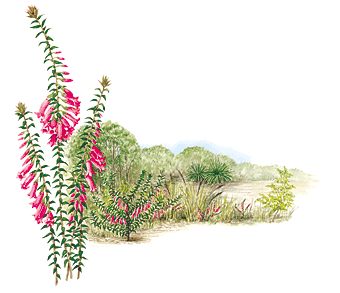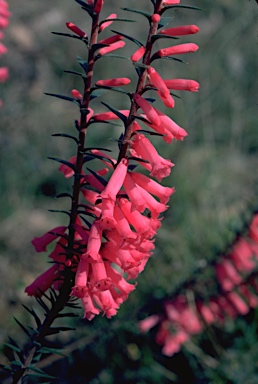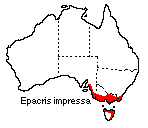 Common
Heath
Common
Heath
Epacris impressa
(plant family: Epacridaceae)
Floral Emblem of Victoria
Representatives of interested Victorian government departments, societies and individuals met on 18 September 1951 and unanimously agreed on Common Heath as the State floral emblem. The pink form of Common Heath, Epacris impressa, was proclaimed the floral emblem of Victoria on 11 November 1958. Victoria was the first Australian State to give official recognition to such an emblem.
 Common
Heath was collected in Tasmania in 1793 by the French botanist, Jacques-Julien
Houtou de Labillardiere during his voyage with Bruny D'Entrecasteaux on
the unsuccessful search for the missing explorer, La Perouse. Following Bruny's
death in July 1793, royalist officers of La Recherche and LEspirance, handed
the ships to the Dutch in Java, where Labillardiere, a republican, was imprisoned
from October 1793 to March 1795. When he returned to France he found that his
plant collection of more than 4000 specimens had been sent to England as a prize
of war. Through the diplomacy of Sir
Joseph Banks the specimens were eventually returned to their collector. Epacris impressa was described by Labillardiere in 1805.
Common
Heath was collected in Tasmania in 1793 by the French botanist, Jacques-Julien
Houtou de Labillardiere during his voyage with Bruny D'Entrecasteaux on
the unsuccessful search for the missing explorer, La Perouse. Following Bruny's
death in July 1793, royalist officers of La Recherche and LEspirance, handed
the ships to the Dutch in Java, where Labillardiere, a republican, was imprisoned
from October 1793 to March 1795. When he returned to France he found that his
plant collection of more than 4000 specimens had been sent to England as a prize
of war. Through the diplomacy of Sir
Joseph Banks the specimens were eventually returned to their collector. Epacris impressa was described by Labillardiere in 1805.
The generic name Epacris is derived from the Greek 'epi', meaning 'upon', and 'akris', meaning 'a hill', referring to the elevated habitat of some species. The specific name impressa, Latin for 'impressed' or 'indented', refers to five dimples on the outside of the basal part of the floral tube. Epacris contains about forty species of evergreen shrubs which occur mainly in temperate eastern Australia and to a minor extent in New Zealand. The family Epacridaceae, the Australian heath family, is distributed mainly in Australia and New Zealand. It is closely related to the Ericaceae, the much larger heather and azalea family which has a greater occurrence in the Northern Hemisphere.
Common Heath is a slender, upright shrub which grows to about a metre in height. The rigid, alternate leaves are stalkless and fairly narrow. They range from 4 to 16 mm in length and are sharply pointed. The tubular flowers up to 25 mm long are arranged singly in the leaf axils and are often so densely packed around the stem that the cluster of flowers assumes a cylindrical brushlike appearance. On other specimens flowers may be sparse and arranged on only one side of the stem. Flowering occurs from late autumn to late spring, reaching a peak in winter. The fruit is a capsule which splits to release minute seeds. Common Heath has many colour forms including pure white, pale pink, rose pink, crimson, scarlet and rare double flowered forms, but the pink form is the one chosen and proclaimed as Victoria's floral emblem. The Grampians Heath, Epacris impressa var. grandiflora, which has wider rosy-crimson flowers and coarser downy greyish foliage, is confined to the Grampian Mountains of western Victoria.
 Common
Heath occurs in coastal heathlands as well as in montane and sub-alpine areas.
It is distributed from Clyde River, New South Wales to the Mt Lofty Ranges in
South Australia. In Victoria it occurs in coastal regions and adjoining foothills,
the Grampians and the Little Desert. It is also common in Tasmania.
Common
Heath occurs in coastal heathlands as well as in montane and sub-alpine areas.
It is distributed from Clyde River, New South Wales to the Mt Lofty Ranges in
South Australia. In Victoria it occurs in coastal regions and adjoining foothills,
the Grampians and the Little Desert. It is also common in Tasmania.
It is a beautiful shrub worthy of cultivation. It may be propagated from seed which is reported to need storage in cool, dry conditions for 12 to 16 weeks after harvesting and prior to sowing. Seed is sown on the surface of soil in pots and must be kept constantly moist. Germination of seeds and initial growth of seedlings are slow. Transplanting requires care in order to avoid damage to the fine roots. Seeds collected from populations of uniform colour come true but variations in flower colour are noted in the progeny of non-uniform populations. Vegetative propagation of desirable forms is carried out using stem cuttings 7 to 8 cm long, taken below the soft tips in late autumn. Successful results are reported using a medium of fine gravel and peat over a base of milled sphagnum moss. A good root system forms in 9 to 10 months without bottom heating. Rooted cuttings and young plants need gentle handling at all stages to avoid root damage. Common Heath is ideally suited for cool, moist areas in well drained, acidic soils. As individual plants tend to be short-lived, a sequence of plantings is recommended to ensure the retention of this beautiful species in the garden. Pruning overcomes its natural straggly habit and may be used to supply cut flowers for indoor decoration, for which they are attractive and last quite well.
It was introduced to English horticulture in 1825 but proved frost tender outdoors. As it flowers at Christmas in the Northern Hemisphere and is suitable for cultivation in cool greenhouses, it is a useful seasonal species for the indoor plant trade. Forms bearing larger flowers in selected colours have been given cultivar names overseas.
Common Heath is depicted in the armorial ensign [illust] granted to Victoria on 28 March 1973 and recorded in the College of Arms, London. The current armorial ensign includes additions made to the earlier one, granted on 6 lune 1910, from which the floral emblem is absent. The more recent blazon, the description of the bearings in heraldic terms, states: 'upon a Compartment of Grass springing therefrom ... a representation of the Floral Emblem for the said State of Victoria that is to say the Pink Form of the Common Heath, Epacris impressa Labill'.
Common heath was featured on the 13 cent stamp [illust] of the State floral emblem set issued on 10 July 1968. R. and P. Warner designed the stamp.
Download a line illustration by Marion Westmacott.©
Download copyright-free illustration by Fay Davies, suitable for childrens' colouring.
Written by Anne Boden for a booklet published by AGPS for the ANBG in 1985.
![An Australian Government Initiative [logo]](/images/austgovt_brown_90px.gif)







